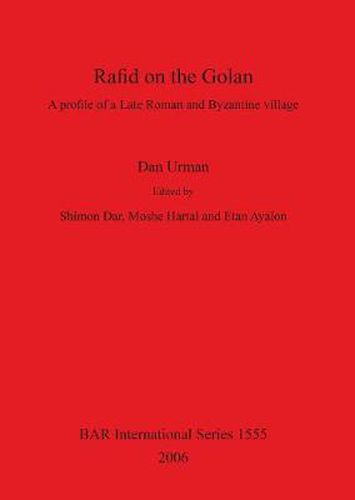Readings Newsletter
Become a Readings Member to make your shopping experience even easier.
Sign in or sign up for free!
You’re not far away from qualifying for FREE standard shipping within Australia
You’ve qualified for FREE standard shipping within Australia
The cart is loading…






This title is printed to order. This book may have been self-published. If so, we cannot guarantee the quality of the content. In the main most books will have gone through the editing process however some may not. We therefore suggest that you be aware of this before ordering this book. If in doubt check either the author or publisher’s details as we are unable to accept any returns unless they are faulty. Please contact us if you have any questions.
On the death of Dan Urman in 2004, his colleagues set about completing his unfinished manuscripts, including this volume: Rafid on the Golan (its ruins remain in a demilitarized zone controlled by United Nations forces), one of Dan Urman’s last archaeological projects. He succeeded in completing the chapters detailing the survey of the houses in the village, carried out during the years 1968-1970. The houses were measured, photographed, and an overall map was drawn, which included all houses, alleys, footpaths, public areas and water reservoirs. The survey team realized that Rafid was an unusual archaeological resource that preserved scores of ancient buildings still standing from foundation to the rafters, constructed of basalt. Dan Urman saw in the survey of Rafid and in the scientific material collected within its framework the highest achievement of the Golan survey: the intact buildings built of decorated basalt could, in his opinion, serve as a model of the building style prevalent in the Roman and Byzantine periods - not only on the Golan, but also on the Korazim and Issachar plateaus. Because of the long time that elapsed between the survey and the preparation of the material for publication, it was necessary to find a Golan expert, who would complete lacunae in the manuscript and present with the rich archaeological material from Rafid also the general background and new research on the Golan and the region bordering on it. Dr. Moshe Hartal from Israel Antiquities Authority, who worked in the original survey team with Dan Urman agreed to work on the manuscript and added the following chapters: The geographical setting, the architectural decorations, the Hauran-style architecture and a synthesis of the history of Rafid in the various historical periods.
$9.00 standard shipping within Australia
FREE standard shipping within Australia for orders over $100.00
Express & International shipping calculated at checkout
This title is printed to order. This book may have been self-published. If so, we cannot guarantee the quality of the content. In the main most books will have gone through the editing process however some may not. We therefore suggest that you be aware of this before ordering this book. If in doubt check either the author or publisher’s details as we are unable to accept any returns unless they are faulty. Please contact us if you have any questions.
On the death of Dan Urman in 2004, his colleagues set about completing his unfinished manuscripts, including this volume: Rafid on the Golan (its ruins remain in a demilitarized zone controlled by United Nations forces), one of Dan Urman’s last archaeological projects. He succeeded in completing the chapters detailing the survey of the houses in the village, carried out during the years 1968-1970. The houses were measured, photographed, and an overall map was drawn, which included all houses, alleys, footpaths, public areas and water reservoirs. The survey team realized that Rafid was an unusual archaeological resource that preserved scores of ancient buildings still standing from foundation to the rafters, constructed of basalt. Dan Urman saw in the survey of Rafid and in the scientific material collected within its framework the highest achievement of the Golan survey: the intact buildings built of decorated basalt could, in his opinion, serve as a model of the building style prevalent in the Roman and Byzantine periods - not only on the Golan, but also on the Korazim and Issachar plateaus. Because of the long time that elapsed between the survey and the preparation of the material for publication, it was necessary to find a Golan expert, who would complete lacunae in the manuscript and present with the rich archaeological material from Rafid also the general background and new research on the Golan and the region bordering on it. Dr. Moshe Hartal from Israel Antiquities Authority, who worked in the original survey team with Dan Urman agreed to work on the manuscript and added the following chapters: The geographical setting, the architectural decorations, the Hauran-style architecture and a synthesis of the history of Rafid in the various historical periods.